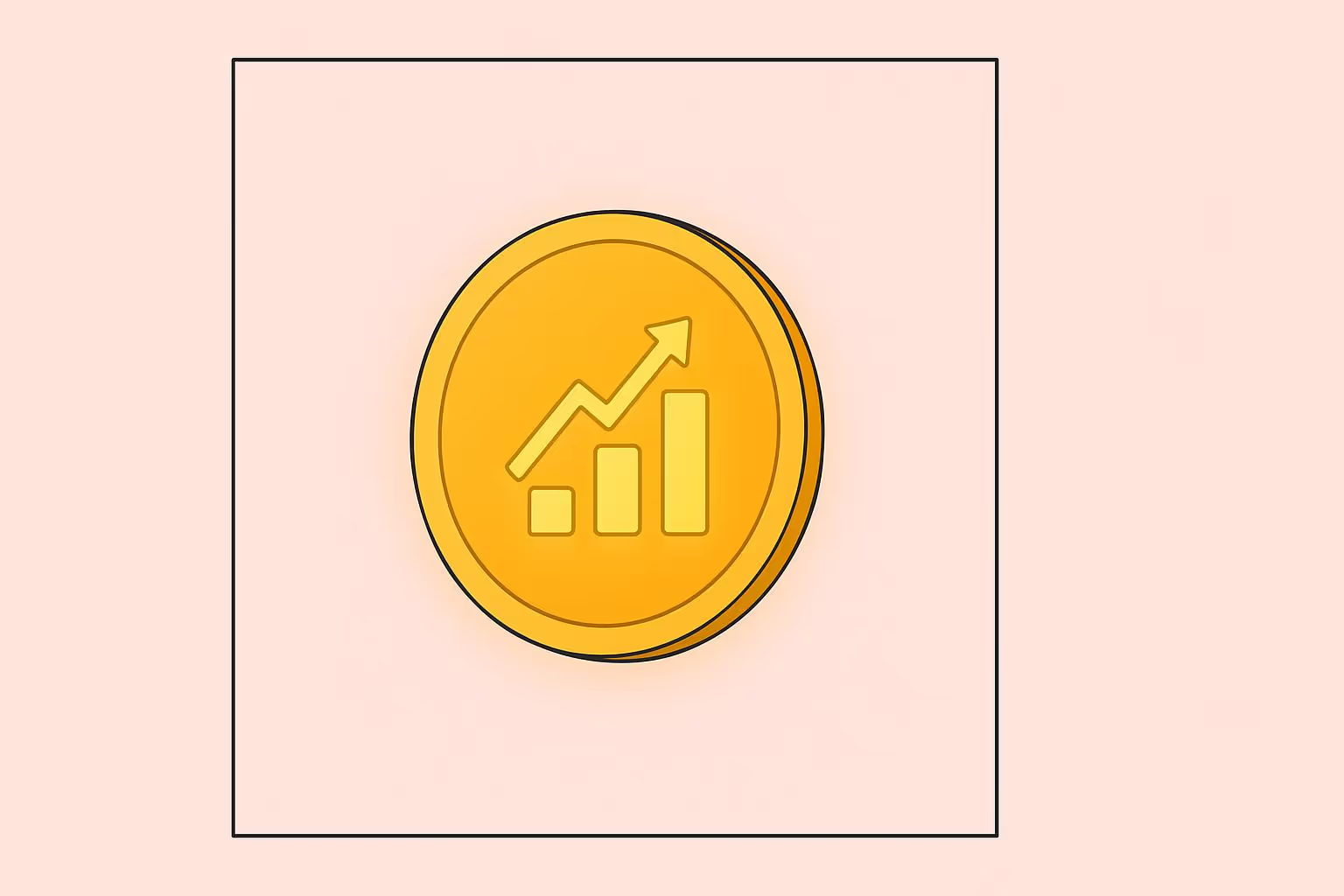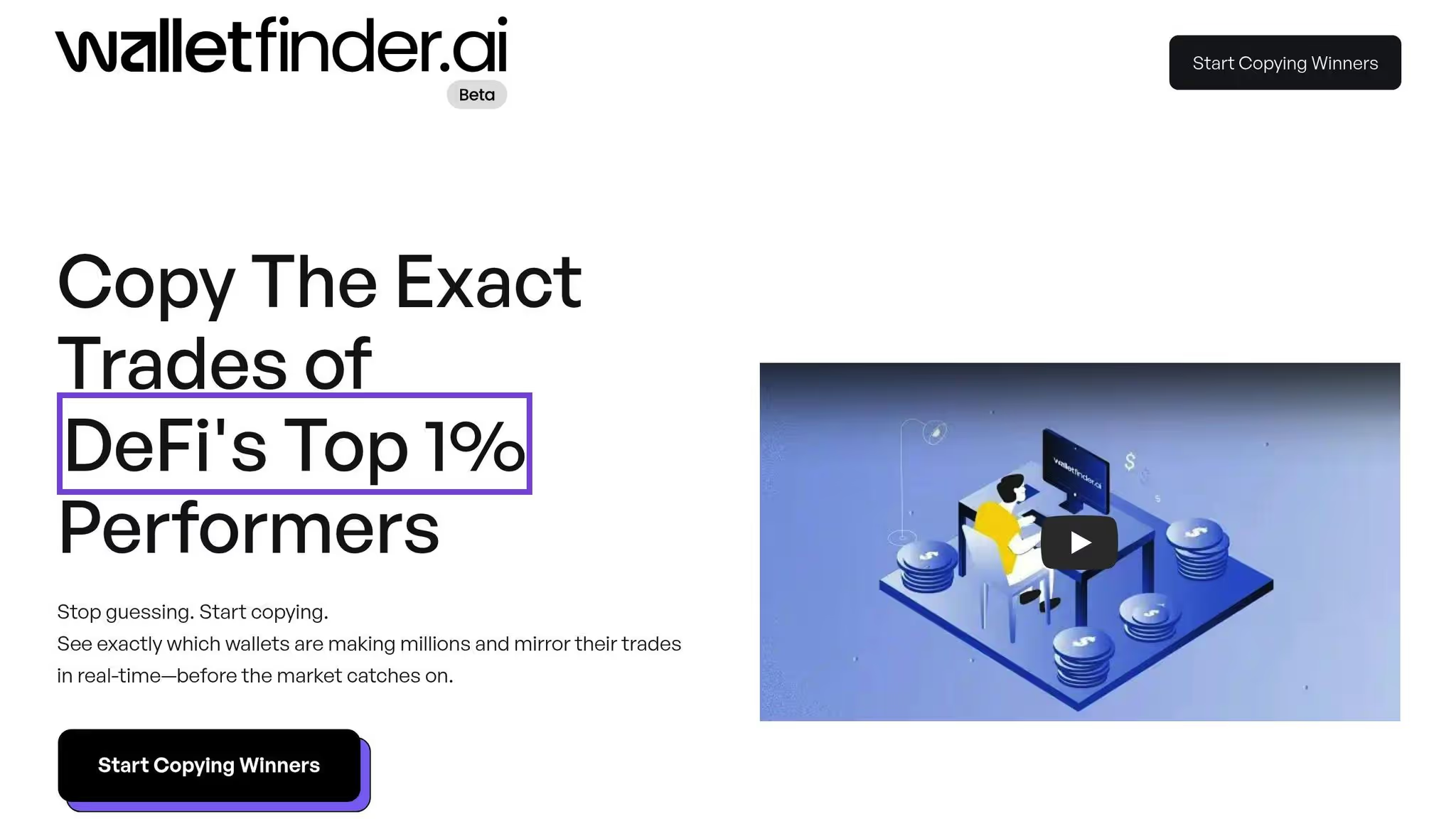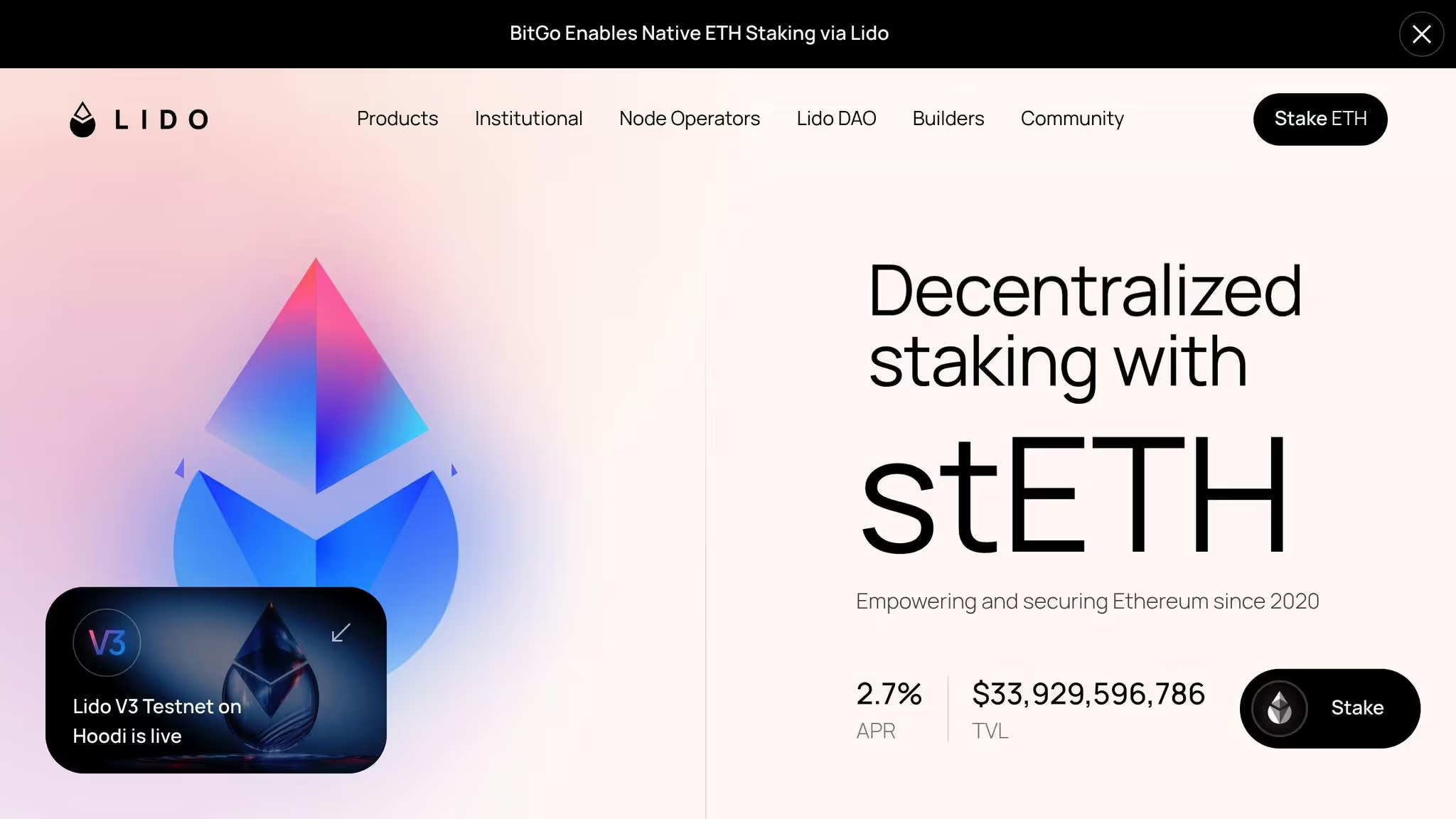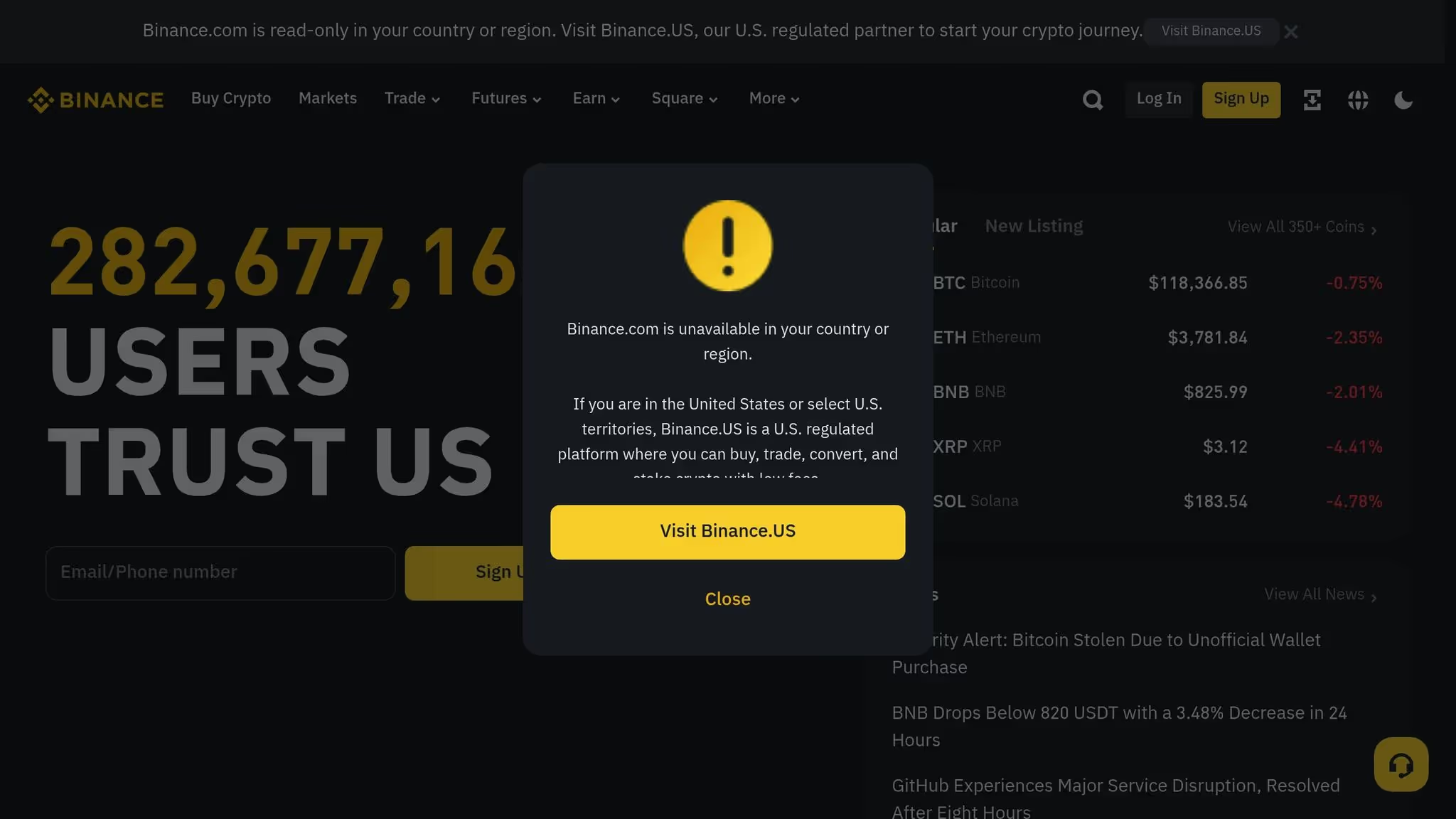A Guide to Raydium Liquidity Pool Profits
Unlock the secrets of the Raydium liquidity pool. This guide explains how to analyze pools, manage risk, and use on-chain data to mirror smart money strategies.

January 2, 2026
Wallet Finder

November 20, 2025

Staking lets you earn passive income with crypto, but managing it across platforms can get tricky. Tools simplify tracking rewards, calculating yields, and handling taxes. Here's a quick look at the top platforms:
Each platform has strengths, like Wallet Finder.ai's analytics, Lido's liquidity, Kraken's compliance, and Binance's asset variety. Choose based on your goals and needs.

Wallet Finder.ai is a powerful tool designed to help crypto investors track staking rewards and wallet performance effortlessly. Built for those who rely on data to make decisions, it offers lightning-fast data loading - under two seconds - so you can analyze multiple staking positions in real time.
This platform is packed with tools to help you get the most out of your staking strategies. Some highlights include:
With these features, you can track successful staking patterns and fine-tune your strategies with ease.
Wallet Finder.ai is built with U.S. investors in mind, offering localized settings to make your experience seamless. Dates are displayed in the familiar MM/DD/YYYY format, and all financial data is shown in USD, complete with proper comma separators for easy reading. This attention to detail ensures that interpreting staking performance feels natural and straightforward.
Security is also a priority. Unlike many wallets that rely on centralized servers - making them vulnerable to cyberattacks - Wallet Finder.ai provides a more secure environment for tracking your data. While the platform’s advanced features may take some time to master, the effort pays off for those seeking in-depth analytics and performance tracking.
Next, we’ll explore other staking tools that can take your analysis to the next level.

Lido Finance has changed the game for staking by addressing one of its biggest challenges: liquidity. Since its launch in 2020, this platform has made it possible to earn staking rewards without locking up your assets. Instead, when you stake, you receive tokens that represent your staked assets - and these tokens can be traded freely.
Lido has grown rapidly, now managing over 27% of all staked ETH and holding a total value locked (TVL) of $33,929,596,522. Since its inception, the platform has distributed an impressive $3,680,363,663 in rewards to its users. Let’s take a closer look at how Lido works and why it’s become so popular.
Lido’s liquid staking model is simple yet powerful. When you stake ETH through Lido, you receive stETH tokens on a 1:1 basis. These tokens don't just sit in your wallet - they can be used in DeFi protocols, giving you flexibility while your staked assets continue earning rewards.
Your stETH balance updates daily at 12:00 PM UTC, automatically reflecting the rewards you’ve earned.
Lido supports staking on three major networks: Ethereum, Solana, and Polygon. For each network, you deposit your tokens and receive liquid staking derivatives that hold their value and generate rewards. Currently, staking ETH through Lido offers an annual percentage rate (APR) of 2.7%.
Getting started is straightforward. Visit stake.lido.fi, connect your wallet, enter the amount of ETH you want to stake, and confirm the transaction. Lido charges a 10% fee on rewards, which is shared between node operators and the Lido DAO treasury to cover operational and security expenses.
Lido doesn’t just make staking easy - it also prioritizes security and community-driven governance. The platform uses a Dual Governance system, where both LDO token holders and stETH holders have a say in decisions. This setup balances governance between the protocol and its users.
Here’s how it works: LDO holders can propose changes, but they need at least 1,000 LDO tokens to submit a proposal. For a proposal to pass, it requires a majority vote and at least 5% of the total LDO supply. Meanwhile, stETH holders can veto decisions they don’t agree with. If more than 1% of the total stETH supply signals opposition, a "Veto Signalling" period is triggered, delaying the proposal for 5 to 45 days. In extreme cases, if over 10% of stETH holders oppose a decision, a "Rage Quit" mechanism kicks in, pausing governance and allowing dissenting stakers to exit.
Lido has invested over $4 million into security measures and has more than 100 integrations across the DeFi ecosystem. Tools like GateSeal are in place to respond quickly to vulnerabilities. Importantly, no single entity can access or control stakers’ funds, as key decisions are executed through smart contracts, with major actions requiring public votes by token holders. To learn more about broader market efforts to strengthen ecosystem stability, read our post on Binance Initiates $400M Together Initiative Aiming for Market Stability.
For U.S. investors looking for a platform that combines liquidity, automated reward tracking, and secure governance, Lido offers a standout solution.

Kraken has made a name for itself in the staking world, becoming the first major centralized exchange to offer onchain staking back in 2019. For U.S. investors, Kraken provides a simple and clear way to track staking rewards.
The platform is available to users in 37 states and 2 territories across the U.S., offering both flexible and bonded staking options. With weekly payouts, it provides consistent updates on earnings. This frequent distribution makes it simpler to keep tabs on your staking progress compared to platforms with longer payout intervals.
Mark Greenberg, Kraken's Global Head of Consumer, highlighted the importance of their U.S. staking launch:
"Launching this new staking product in the U.S. is an overwhelmingly positive development, not just for Kraken but also for the entire U.S. crypto space."
Let’s take a closer look at Kraken’s asset offerings and yield options.
As of July 29, 2025, Kraken allows staking for 17 different assets, including popular cryptocurrencies like ETH, SOL, DOT, and ADA. This variety gives users the chance to diversify their portfolios.
Kraken offers staking yields of up to 17% annually, depending on the asset. The platform provides two staking methods: flexible staking, which allows users to unstake their assets anytime without penalties, and bonded staking, which requires locking assets for a set period but offers higher returns.
The Auto Earn feature enables users to earn passive income from idle assets while keeping funds accessible. This is a great option for those who want to boost their earnings without constant oversight.
Kraken also supports Bitcoin staking, where users can earn up to 1% in $BABY tokens. Additionally, U.S. investors can explore ETH restaking, opening up more earning opportunities beyond traditional staking.
To use these features, users need an account verified to the Intermediate level or higher and must not reside in restricted areas. U.S. clients can manage their staking activities conveniently through Kraken Pro.
In addition to its staking options, Kraken places a strong focus on security and compliance, ensuring a safe experience for U.S. users.
Kraken prioritizes security, stating that "Protecting your funds and privacy is our number one objective". The platform has achieved ISO/IEC 27001:2013 certification and completed a SOC 2, Type 1 examination, showcasing its adherence to leading security practices.
User assets are protected with cold storage, hot wallet systems, and end-to-end encryption. Access to sensitive data is tightly managed and monitored.
For U.S. users, Kraken offers additional security features like FIDO2-compliant 2FA with Passkeys and avoids phone/SMS account recovery to reduce the risk of SIM-swapping attacks. Users can also customize API key permissions and must confirm new withdrawal addresses via email.
Extra protection options include configurable account timeouts and global settings time locks for heightened security. SSL encryption is used for all browsing, and the platform continuously monitors for suspicious activity in real time.
Kraken also conducts Proof of Reserves audits with external auditors to ensure transparency. The company collaborates with U.S. law enforcement agencies, such as the Secret Service, to assist in crypto fraud investigations.
To maintain a high level of security, Kraken runs regular testing, offers a bug bounty program, and even evaluates third-party products through Kraken Security Labs to improve safety across the crypto industry.
For urgent issues, Kraken provides 24/7 live chat and email support, ensuring help is always available. With its focus on security, compliance, and user-friendly features, Kraken stands out as a dependable choice for U.S. investors looking to maximize and monitor their staking rewards.

Binance has positioned itself as a go-to platform for staking analysis, offering tools tailored for investors looking to diversify their staking portfolios. Through its Binance Earn product, the platform supports over 300 cryptocurrencies, making it one of the most extensive choices available for U.S. investors. These features lay the groundwork for Binance's wide range of staking options, which we’ll explore below.
Binance also makes tracking staking rewards straightforward. As the platform explains:
"Binance Earn offers a suite of products for you to grow your crypto holdings easily through passive rewards... Whether you're a beginner or an advanced investor, Binance Earn offers flexible and secure options to potentially maximize returns."
With staking rewards reaching up to 33% APY and support for over 60 cryptocurrencies specifically for staking, Binance offers opportunities for significant earnings across various blockchain networks.
Binance provides several staking options to suit different investor preferences and risk levels. Locked Staking requires users to commit their crypto for a set period, offering higher rewards in return. Meanwhile, Flexible Staking allows users to withdraw their assets anytime, though the returns are typically lower. For those interested in decentralized finance, Binance also offers DeFi Staking options.
The platform’s analytics tools are designed to give users a clear picture of their staking performance. Investors can track daily earnings, monitor APY fluctuations, and compare the performance of different staking products in real time. These tools help users find the right balance between liquidity and maximizing returns.
In addition to its analytics tools, Binance emphasizes strong security measures for U.S. investors. Binance.US operates as a fully regulated crypto exchange, registered with FinCEN and holding multiple money transmitter licenses across various states. To protect customer assets, the platform maintains 1:1 reserves, with most funds stored offline in cold wallets and active funds safeguarded by advanced security protocols.
Real-time monitoring plays a big role in Binance.US’s security framework. The platform uses a risk management system to continuously check withdrawals, deposits, and account changes. If suspicious activity is detected, withdrawals are automatically suspended. Binance also ensures 99.99% uptime, so users can earn staking rewards without interruption. For those looking to maximize returns, exploring the Top Features of Yield Farming Monitoring Tools can provide valuable insights.
For added protection, Binance maintains a $1 billion insurance fund (SAFU) to safeguard users in case of security breaches. In 2024, the platform blacklisted over 47,000 malicious addresses, preventing an estimated $129 million in potential losses. Through its Anti-Scam Refund Initiative, Binance also recovered $9.1 million in stolen funds. Read more about recent market events in Crypto Market Experiences $250M Liquidations in One Hour.
Binance.US has earned independent certifications for data privacy and security, including ISO/IEC 27701:2022 and 27001:2013 accreditation. Users can enhance their account security with two-factor authentication, withdrawal address whitelists, and anti-phishing codes. These measures not only protect users but also ensure the stability of the platform for tracking rewards.
Binance is also transparent about its fund management practices. According to the platform:
"User assets are tracked entirely separately from Binance's corporate holdings. Binance maintains completely separate ledgers for user funds, pegged assets, and its own holdings. At any given moment, we know exactly how much money each of our users is entitled to, and we hold sufficient funds to honor any withdrawal request. And, again, it's all verifiable via the PoR system."
This level of transparency reassures U.S. investors that their staking rewards and principal amounts are secure, making Binance a reliable choice for long-term staking strategies.
When picking a staking analysis tool, it’s important to match platform features with your investment goals and comfort with risk. Each tool has its strengths - some focus on detailed wallet analytics, while others specialize in tracking on-chain rewards. The table below lays out the core features of each platform, helping you decide which one fits your staking strategy.
Multiple DeFi tokens
, profit/loss analysis, custom alerts, historical performance graphs, trading pattern analysis
Advanced filtering, data export, Telegram alerts
Full U.S. access
Varies by tracked wallets
ETH, MATIC, SOL, DOT
Liquid staking rewards, daily reward tracking, validator performance monitoring
Decentralized governance, regular smart contract audits
Available in most U.S. states
3.15% APR for ETH
16 cryptocurrencies including ETH, ADA, SOL, DOT
On-chain staking analytics, real-time APY tracking, reward distribution monitoring
Cold storage, multi-signature wallets, regulatory compliance
Full U.S. access
Up to 20% APY
A select range of cryptocurrencies for staking
Flexible and locked staking options, real-time earnings tracking, APY comparison tools
SAFU insurance fund, anti-fraud protocols
Binance.US available with state restrictions
Variable (by asset)
Each platform brings something different to the table. Kraken supports 16 cryptocurrencies and focuses on on-chain staking, offering yields through Proof-of-Stake mechanisms. Wallet Finder.ai is ideal for investors who want detailed wallet analysis, including historical performance graphs and real-time alerts via Telegram. Meanwhile, Lido provides liquid staking, letting users earn rewards without giving up liquidity. Binance stands out for its flexible staking options and APY comparison tools.
When it comes to security, each platform has its own approach. Binance uses a SAFU insurance fund and anti-fraud measures, Kraken prioritizes compliance with cold storage and multi-signature wallets, and Lido relies on decentralized governance and frequent smart contract audits.
U.S. accessibility also varies. Wallet Finder.ai and Kraken offer full access, while Binance operates through Binance.US with some state restrictions. Lido is available in most states, but coverage may depend on local regulations.
Reward potential differs significantly. Lido offers 3.15% APR for ETH, while Kraken provides up to 20% APY. Wallet Finder.ai and Binance offer variable returns, influenced by market conditions and asset types.
For those who value detailed analytics, Wallet Finder.ai is a strong choice. Investors prioritizing a wide range of assets might lean toward Binance, while those focused on regulatory compliance and security may prefer Kraken. Ultimately, the best platform depends on what matters most to your staking strategy - whether it's analytics, asset diversity, security, or compliance.
Choosing the right staking tool can make a big difference in both returns and ease of management. With $73.4 billion worth of ETH staked - representing 23% of the total supply as of January 2024 - the staking market has grown significantly. This growth underscores the importance of using tools that work seamlessly with financial reporting systems.
For U.S. investors, focusing on security, compliance, ease of use, asset diversity, and APY tracking is essential. Regulatory clarity and tax implications are critical, especially with the complicated reporting requirements for staking rewards under U.S. tax law. Integrating staking tools with existing accounting systems is a must for accurate reporting and staying compliant.
"Accurate accounting for staking rewards keeps you compliant and financially sound: Understand the rules under IFRS or GAAP. Detailed records are key, and specialized software can help manage the complexity of staking." - Cryptoworth Blog
Platforms like Wallet Finder.ai provide detailed analytics, real-time tracking, and automated alerts, giving U.S. investors the tools they need for precise staking insights. With advanced filtering options, data export features, and seamless integration with personal wallets, Wallet Finder.ai simplifies performance tracking. The platform also offers historical performance graphs and trading pattern analysis, helping investors make informed decisions.
With APYs ranging from 4% to over 23%, achieving strong returns depends on using robust analytics to manage risks and maintain compliance. Whether you choose Wallet Finder.ai or another specialized solution, the most important step is selecting a tool that fits your investment goals and technical preferences.
Wallet Finder.ai puts security front and center with non-custodial staking. This means you can stake your assets directly from your wallet without depending on third-party platforms. By cutting out external intermediaries, you stay in full control of your funds, minimizing potential risks.
To keep your assets even safer, the platform uses advanced analytics and real-time monitoring to spot any unusual activity. This extra layer of protection helps safeguard both your wallet and your staking rewards. Plus, Wallet Finder.ai works smoothly with trusted tools like MetaMask, making it easy to track and manage your staking performance without hassle.
Lido's liquid staking lets you earn rewards while keeping your assets accessible. With continuous liquidity, you can use your staked funds whenever you need them. Plus, it opens up opportunities to use those staked assets in DeFi activities like lending or trading, giving you more ways to grow your earnings.
One of the standout benefits is avoiding the usual lock-up risks tied to traditional staking. With Lido, there's no need to wait through an unbonding period to access your funds. This means you get more flexibility and control over your investments.
Kraken places a strong emphasis on the security and compliance of its staking services for users in the United States. To demonstrate this, the company follows strict cybersecurity measures and adheres to regulatory requirements. In February 2023, Kraken settled charges with the SEC by ending its U.S. staking program and agreeing to a $30 million settlement. This step highlights Kraken's dedication to following U.S. regulations and ensuring the trust of its users.
{"@context":"https://schema.org","@type":"FAQPage","mainEntity":[{"@type":"Question","name":"How does Wallet Finder.ai ensure secure tracking of staking rewards?","acceptedAnswer":{"@type":"Answer","text":"<p>Wallet Finder.ai puts security front and center with <strong>non-custodial staking</strong>. This means you can stake your assets directly from your wallet without depending on third-party platforms. By cutting out external intermediaries, you stay in full control of your funds, minimizing potential risks.</p> <p>To keep your assets even safer, the platform uses <strong>advanced analytics</strong> and <strong>real-time monitoring</strong> to spot any unusual activity. This extra layer of protection helps safeguard both your wallet and your staking rewards. Plus, Wallet Finder.ai works smoothly with trusted tools like <a href=\"https://metamask.io/\" target=\"_blank\" rel=\"nofollow noopener noreferrer\">MetaMask</a>, making it easy to track and manage your staking performance without hassle.</p>"}},{"@type":"Question","name":"What are the benefits of Lido's liquid staking model for earning rewards while keeping your assets accessible?","acceptedAnswer":{"@type":"Answer","text":"<p>Lido's liquid staking lets you earn rewards while keeping your assets accessible. With <strong>continuous liquidity</strong>, you can use your staked funds whenever you need them. Plus, it opens up opportunities to use those staked assets in DeFi activities like lending or trading, giving you more ways to grow your earnings.</p> <p>One of the standout benefits is avoiding the usual lock-up risks tied to traditional staking. With Lido, there's no need to wait through an unbonding period to access your funds. This means you get more flexibility and control over your investments.</p>"}},{"@type":"Question","name":"How does Kraken ensure the security and compliance of its staking services for U.S. users?","acceptedAnswer":{"@type":"Answer","text":"<p>Kraken places a strong emphasis on the security and compliance of its staking services for users in the United States. To demonstrate this, the company follows strict cybersecurity measures and adheres to regulatory requirements. In February 2023, Kraken settled charges with the SEC by ending its U.S. staking program and agreeing to a $30 million settlement. This step highlights Kraken's dedication to following U.S. regulations and ensuring the trust of its users.</p>"}}]}